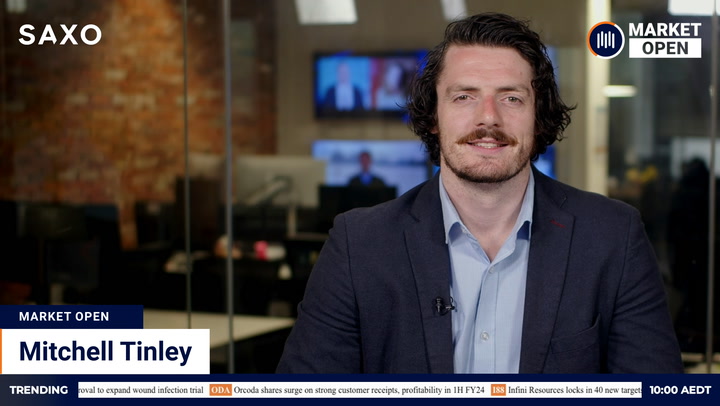The Australian stock market’s tentative recent recovery looked set to accelerate after Wall Street capped a strong comeback week with its biggest rise in two years.
ASX futures surged 103 points or 1.59 per cent as US stocks snapped a three-week losing streak.
Wall Street’s main indices put on between 2.7 and 3.3 per cent as falling commodity prices and signs of a slowdown soothed rates worries.
Oil, gold and iron ore steadied at the end of a bruising week. Copper added to its biggest weekly loss in a year. Nickel, tin and zinc logged heavy declines. The dollar bounced back above 69 US cents.
Wall Street
US stocks surged on expectations weakening economic signals and declining commodity prices will limit the scale of interest rate rises.
The S&P 500 jumped 116 points or 3.06 per cent. The Dow Jones Industrial Average gained 823 points or 2.68 per cent. The Nasdaq Composite advanced 375 points or 3.34 per cent.
Friday’s returns burnished a fierce rebound. The S&P 500 put on 6.5 per cent for the week, the Nasdaq 7.5 per cent and the Dow 5.4 per cent.
CME’s closely-followed FedWatch took showed investors now expect official rates to peak at 3.5 per cent in December, down from 3.75 per cent a week ago. The gauge also suggests the central bank could start cutting 12 months from now.
“We’ve seen a two-week drop in commodity prices and now we are seeing Fed funds futures pricing in rate cuts out in 2023. The thing holding back the market was endless rate hikes, if we’ve found the terminal rate then stocks can make headway here,” Mike Antonelli, market strategist at Baird, said.
Consumer sentiment hit a record low this month, adding to a run of bleak economic reports. However, investors were encouraged by a fractional improvement in inflation expectations. The University of Michigan’s survey showed Americans expect inflation to rise at an annualised rate of 5.3 per cent, down from a preliminary reading of 5.4 per cent.
Travel stocks surged after cruise company Carnival reported the best quarterly booking figures since the start of the pandemic. The three leading cruise companies booked double-digit gains. The S&P 500 Airlines Index jumped 5.88 per cent.
Positive results from the Federal Reserve’s annual bank stress tests helped launch the financial sector up 3.8 per cent. The Fed said banks had “strong capital levels, allowing them to continue lending to households and businesses during a severe recession”.
Not all analysts were convinced last week marked a turning point in this year’s US bear market. Some pointed out the action mirrored several sharp rebounds during a broader downtrend since January.
“We believe that bounce in U.S. equity markets over the past three trading days has been a bear market rally off deeply oversold conditions,” Chris Senyek of Wolfe Research wrote.
“While there may be some additional near-term follow through, we believe that our intermediate-term bearish base case remains intact and that the next leg down is going to be driven by rising recession risks and downward earnings revisions,” he added.
Australian outlook
The bulls are temporarily back in control, setting up a strong start to the Australian trading week. The S&P/ASX 200 bounced 1.6 per cent last week and could double that tally by this afternoon if positive market sentiment survived the weekend.
Friday’s US gains were spectacular. More than half the 11 sectors gained more than 3 per cent. The two that count most here – materials and financials – were among the top three.
The materials sector led with a rise of 3.98 per cent. Financials was close behind with a gain of 3.8 per cent. Industrials and the three sectors dominated by ‘Big Tech’ made up the top six.
Energy, utilities and health brought up the rear while still booking gains of 1.5-1.7 per cent.
It’s too early to say the worst of this year’s correction is behind, but sentiment has certainly improved in the short term. A brutal tax loss selling season ends this week, removing one domestic headwind.
The S&P/ASX Emerging Companies Index, home to many of the market’s more speculative investments, has fallen 17.5 per cent this month, twice as much as the ASX 200. The Small Ords has lost 11.9 per cent.
The end of the quarter/financial year is likely to see heightened volatility at the top end as institutional traders put the best possible gloss on portfolios before reporting to investors. Much of the selling should be over by now, but late scrambles are not unknown.
A fairly light week for domestic economic data includes weekly consumer confidence (Tuesday); retail sales (Wednesday); private-sector credit (Thursday); and manufacturing (Friday).
Likely highlights in the US include: durable goods orders (tonight); consumer confidence (Tuesday); a panel discussion involving Fed Chair Powell (Wednesday); consumer price index (Thursday); and manufacturing (Friday).
A swag of REITs go ex-dividend on Wednesday. Among those to trade without the right to the next distribution are Goodman Group, Dexus, Stockland and Mirvac. Toll road operator Transurban also goes ex-dividend that day.
IGA operator Metcash releases full-year results today. CSR holds its AGM on Thursday.
IPOs: there are three listings currently pencilled in for this week. Bindi Metals is set to debut tomorrow. Chalkos Metals and Sarytogan Graphite are scheduled for Thursday.
The dollar bounced 0.57 per cent this morning to 69.44 US cents.
Commodities
Oil rebounded with the general improvement in risk appetite, erasing losses earlier in the week. Brent crude settled US$3.07 or 2.8 per cent ahead at US$113.12 a barrel. The recovery left the international benchmark flat for the week.
Industrial metals added to a week of heavy losses amid fears about the demand hit from a global slowdown. Tin plunged 8.3 per cent to US$25,055 a tonne on the London Metal Exchange. Nickel dived 6.8 per cent to US$22,359.50. Zinc lost 6.1 per cent, closing at US$3,485.
Benchmark copper eased 0.2 per cent, aluminium 1.1 per cent and lead 1.7 per cent.
“There is a risk of further losses,” independent analyst Robin Bhar told Reuters. “A sharp economic slowdown or recession seems to be on the cards.”
Iron ore prices were mixed at the end of a losing week as Chinese steel mills cut production. The spot price for ore landed in China declined 79 US cents or 0.6 per cent to US$128.53 a tonne. The most-traded ore contract on the Dalian Commodity Exchange firmed 1 per cent to US$109.90.
Prices steadied at the end of last week after Chinese President Xi Jinping pledged support for the economy. However, the absence of specific measures limited buying interest.
BHP‘s US-traded depositary receipts rallied 2.87 per cent. The miner’s UK stock rebounded 1.68 per cent. Rio Tinto tacked on 3.14 per cent in the US and 1.41 per cent in the UK.
Gold trimmed a losing week. Metal for August delivery settled 50 US cents or less than 0.1 per cent higher at US$1,830.30 an ounce. The NYSE Arca Gold Bugs Index climbed 2.74 per cent.
For the week, gold lost around 0.6 per cent. Silver shed 2.1 per cent.





